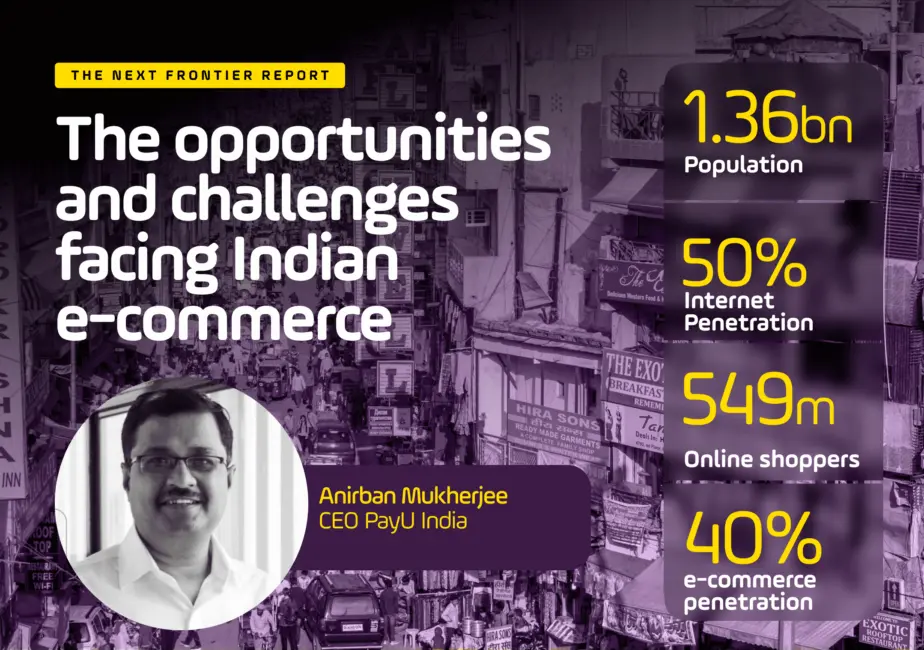Leadership through knowledge
Take a deep dive into the rapidly changing world of e-commerce and fintech.
Visit resource hubAnirban Mukherjee, CEO of PayU India, looks at some of the key drivers behind e-commerce amongst the world’s second-largest consumer population.

With a vibrant homegrown tech sector and an average age of just 28 years old, e-commerce in India is in the midst of a sustained boom – one that is set to continue as millions of additional Indians join the middle class and efforts at digital and financial inclusion increase.
Fueled by growing smartphone penetration and affordable internet options, e-commerce has already become an entrenched way of life in urban areas, and is making rapid inroads in rural locations too. Amazingly, still only half of India’s 1.36 billion population are online – pointing to a bright future for digital products and services in a country that adds an average of 10 million new internet users each day.
What is the overall outlook for e-commerce and online payments in India? And what are the challenges and opportunities going forward? As part of The Next Frontier, PayU’s recent report on e-commerce opportunities in emerging markets, we reached out to Anirban Mukherjee, CEO of PayU India, to share his thoughts on the present and future of Indian e-commerce.
Scroll below to read Anirban’s responses and be sure to check out our other recent posts on the digital landscape in some of the world’s top emerging e-commerce markets.

2020 accelerated the adoption of digital services in India in a way which no other year could have done. COVID-19 has pushed contactless and digital payments to new age groups and locations in India, reaching more rural areas and older age groups.
The sudden arrival of the pandemic also pushed businesses to explore cross-industry collaboration, particularly with regards to supply chain management, digital payments and lending, and logistics. As digital accessibility continues to increase, India’s internet economy is growing with it.
Many retail businesses have recognized that in order to expand operations and scale they will need to collaborate with e-commerce platforms, as well as offer e-payments solutions to cater to evolving, mobile-first customers. India crossed half a billion smartphone users in 2020, which in turn led to more consumers turning to their devices for various needs – from financial to retail to educational.
The Indian government is also making a concerted effort to digitize payments and move away from a cash economy. The behavior change in consumers seen in 2020, as well as the increased availability of cheaper devices and simpler payment modes (such as Unified Payments Interface) are all driving increased e-commerce.

Firstly, India is predominantly a cash-based economy. The low uptake of credit and debit cards, as well as alternative payment methods, is partly due to a cultural reliance on cash, and is compounded by an underdeveloped digital payment infrastructure. This means that even consumers who are willing to make digital purchases do not always have the means to do so, despite the rapid advances in this field. Even popular payment solutions such as UPI are more dominant in person-to-person (P2P) rather than person-to-merchant (P2M) transactions.
Secondly, how businesses use personal data and, in particular, the consequences of data breaches, are high on the political agenda, with a new bill likely to be tabled in parliament soon. However, most e-commerce firms have not developed actionable roadmaps to manage this. Fraudulent transactions are one of the key problems hampering further growth of the e-commerce sector today. Since the shift to digital in India is fairly recent, and accelerated suddenly due to COVID-19, consumer education about staying safe online is still lacking.
However, these challenges can be mitigated by working with a verified payments partner with extensive local expertise, such as PayU. Such partners can tailor payment technologies to the needs of the local population, as well as enhance the shopping experience and increase security against fraud for consumers. This is essential for any merchant looking to expand in India.
The potential for omnichannel solutions – convergence of offline and online payment solutions – is vast. Essentially, it enables the consumer to move smoothly between digital and physical payments with solutions such as UPI, QR codes and payment links. The advances in payment solutions allow e-commerce firms to create multiple touchpoints and access a wider range of customers.
There is huge scope for digitizing the end-to-end value chain, for SMEs as well as enterprise-scale businesses. It is imperative to create infrastructure which helps to solve merchants’ problems, such as augmenting sales and connecting them to digitally enabled consumers. This will add value for merchants and help to propel e-commerce growth.
The shift from traditional cash to e-payments will occur along a continuum, which will also include middle-of-the-road “phygital” (physical plus digital) solutions.
To invest in robust physical and digital infrastructure. For optimum customer experiences, this should encompass logistics infrastructure, digital payment and lending capabilities, scalable networks, and a privacy and data protection framework. The importance of strong core operational processes cannot be understated in a large market like India, with significant urban and rural opportunities to be tapped.

Get further insights on the e-commerce landscape across Romania and nearly 20 other emerging e-commerce markets where PayU operates around the world.
Combining external sources with local data directly from PayU’s payments platform, our report also provides a window into the payment ecosystem across the countries surveyed, leveraging our experience as a leading payment technology platform offering merchants a single global solution for emerging as well as established markets.
Fill in the form to download our report and learn more about the fast-moving digital landscape in some of the world’s most exciting growth markets for e-commerce.